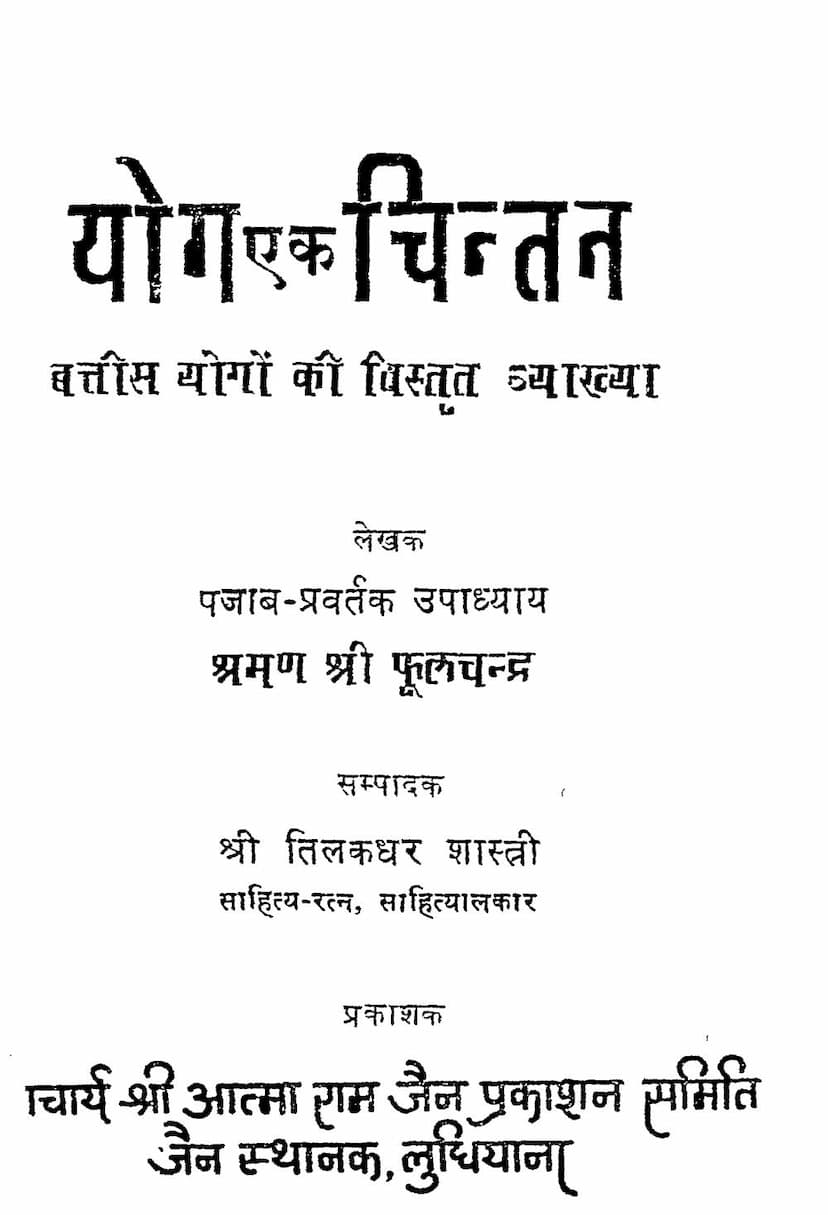Yog Ek Chintan
Added to library: September 2, 2025

Summary
Here's a comprehensive summary of the Jain text "Yog Ek Chintan" (A Contemplation on Yoga) by Fulchandra Shraman, edited by Tilakdhar Shastri, and published by Atmaram Jain Prakashan Samiti:
Overall Theme and Purpose:
"Yog Ek Chintan" is a Jain treatise that delves into the concept of Yoga, not just as a physical practice, but as a profound spiritual discipline deeply rooted in Jain philosophy. The book focuses on a detailed explanation of the Thirty-Two Yogas as described in the Samavāyānga Sūtra, an important Jain scripture. The author, Fulchandra Shraman, a respected Jain monk and scholar, aims to present Yoga as an integral part of the Jain path to liberation (moksha), highlighting its conceptual parallels and integration with core Jain principles.
Key Concepts and Structure:
The book is structured around the meticulous exposition of the thirty-two yogas, which are presented as essential steps or practices for spiritual advancement. Each of the thirty-two yogas is discussed in detail, explaining its meaning, significance, and practical application within the Jain framework.
Core Arguments and Connections to Jainism:
-
Yoga as a Jain Path: The central thesis is that Yoga, in its multifaceted forms, is not foreign to Jainism but is, in fact, a fundamental component of the Jain spiritual journey. The book argues that Jainism's emphasis on self-control, purification, and spiritual liberation is intrinsically linked to yogic practices.
-
Samavāyānga Sūtra's Thirty-Two Yogas: The primary focus is on the thirty-two yogas listed in the Samavāyānga Sūtra. These yogas are presented as a practical guide for spiritual aspirants, detailing the various facets of righteous conduct, mental discipline, and spiritual exertion required for progress.
-
Parallels with Patanjali's Yoga: The editor, Tilakdhar Shastri, in his "My Experience," draws significant parallels between Patanjali's Yoga Sutras and the Jain concept of Yoga and the thirty-two yogas. He argues that Patanjali's "Yogashchittavritti-nirodhaḥ" (Yoga is the cessation of the modifications of the mind) aligns with the Jain goal of controlling mental fluctuations to achieve spiritual insight. Shastri highlights concepts like "Abhyasa" (practice) and "Vairagya" (dispassion) in Patanjali's Yoga, finding their roots in Jain principles like "Yatana" (effort) and "Samyama" (restraint) and "Vairagya" (renunciation).
-
Emphasis on Internal Transformation: The book strongly emphasizes that true Yoga is not merely about external postures or rituals but about internal purification, self-discipline, and the eradication of passions (kashayas). This aligns perfectly with Jainism's focus on inner transformation and the shedding of karmas.
-
Rejection of Mere Physicality: The author and editor critique the modern tendency to reduce Yoga to mere physical exercises or asanas. They stress that while asanas might be a preparatory step, the true essence of Yoga lies in mental and spiritual discipline.
-
Detailed Explanation of Key Yogas (Examples):
- Ālocanā (Critique/Confession): The first yoga discussed, Ālocanā, is explained as the sincere confession of one's faults to a spiritual guide. This is presented as a crucial step in self-purification and spiritual growth, mirroring the Jain practice of confession and repentance.
- Niravalope / Niraplāp (Maintaining Secrecy / Non-Fabrication): This yoga emphasizes the importance of not revealing the faults confessed by others and of speaking truthfully without exaggeration or fabrication.
- Dridh-dharmata (Steadfastness in Dharma): This yoga highlights the importance of remaining firm in one's religious principles, even during times of adversity or hardship.
- Anishritopadhān (Tapas without dependence): This refers to asceticism performed without reliance on external aids or for the attainment of worldly pleasures, emphasizing the purity of motive for self-liberation.
- Shiksha (Discipline/Learning): This yoga covers the process of acquiring knowledge and spiritual discipline, underscoring the importance of both theoretical learning (grahaṇ-śikṣā) and practical application (āsevan-śikṣā).
- Vyutsarga (Renunciation of the Body/Self-Detachment): This yoga emphasizes detachment from the physical body and worldly possessions, viewing the body as impure and transient.
- Alōbh (Non-greed): This yoga focuses on the complete abandonment of greed, which is seen as the root of many vices.
- Dhyana-Sanvara-Yoga (Yoga of Meditation and Restraint): This highlights meditation as a crucial practice for controlling the mind, senses, and actions, leading to restraint and spiritual progress.
- Samaya (Equanimity): The concept of maintaining equanimity and impartiality towards all beings and situations is stressed.
- Shukla Dhyāna (Pure Meditation): The book discusses the highest form of meditation, Shukla Dhyāna, which leads to the cessation of karmas and liberation.
- Brahmacharya (Celibacy/Spiritual Conduct): This yoga emphasizes the control of sensual impulses and the discipline of mind, speech, and body.
- Samādhī (Concentration/Absorption): This yoga focuses on achieving mental concentration and absorption in the spiritual goal.
- Māraṇāntika Ārādhanā (Auspicious Death): The final yoga discussed, Māraṇāntika Ārādhanā, deals with the Jain concept of Sallekhanā (voluntary fasting leading to death), viewing death not as an end but as a spiritual transition achieved through perfect equanimity and detachment.
-
Influence of Jain Culture: The book consistently points out how various aspects of Yoga, from the ethical restraints to the meditative practices, are deeply interwoven with and supported by Jain cultural and philosophical tenets.
In Essence:
"Yog Ek Chintan" is a valuable contribution to Jain literature that systematically expounds the yogic path as prescribed within the Jain tradition, primarily through the lens of the thirty-two yogas from the Samavāyānga Sūtra. It serves as a guide for spiritual seekers, demonstrating that the path to liberation, as understood in Jainism, is a comprehensive yogic journey of self-discipline, purification, and profound contemplation. The book aims to revive and elucidate the integral role of Yoga within the Jain spiritual framework.